|
|
–Р–љ–µ–Љ–Њ–љ—Л, anemones, sasanky, an√©mones, anemoni, an√™monas, an√©monas
|

12.01.2013, 19:46
|
|
–Р–і–Љ–Є–љ–Є—Б—В—А–∞—В–Њ—А
|
|
–†–µ–≥–Є—Б—В—А–∞—Ж–Є—П: 07.09.2010
–°–Њ–Њ–±—Й–µ–љ–Є–є: 7,940
|
|
|

16.01.2013, 15:08
|
|
–Р–і–Љ–Є–љ–Є—Б—В—А–∞—В–Њ—А
|
|
–†–µ–≥–Є—Б—В—А–∞—Ж–Є—П: 07.09.2010
–°–Њ–Њ–±—Й–µ–љ–Є–є: 7,940
|
|
|

01.03.2013, 08:23
|
|
–Р–і–Љ–Є–љ–Є—Б—В—А–∞—В–Њ—А
|
|
–†–µ–≥–Є—Б—В—А–∞—Ж–Є—П: 07.09.2010
–°–Њ–Њ–±—Й–µ–љ–Є–є: 7,940
|
|
 –Ь–Ъ –ї–µ–њ–Ї–∞ "–Т–µ—В—А–µ–љ–Є—Ж–∞ –і—Г–±—А–∞–≤–љ–∞—П" -Wooden Anemone (Anemone nemorosa) tutorial V2
–Ь–Ъ –ї–µ–њ–Ї–∞ "–Т–µ—В—А–µ–љ–Є—Ж–∞ –і—Г–±—А–∞–≤–љ–∞—П" -Wooden Anemone (Anemone nemorosa) tutorial V2
–Ь–Ъ –ї–µ–њ–Ї–∞ "–Т–µ—В—А–µ–љ–Є—Ж–∞ –і—Г–±—А–∞–≤–љ–∞—П" -Wooden Anemone (Anemone nemorosa) tutorial
 –Ь–Ъ –Ч–Ф–Х–°–ђ - TUTORIAL HERE
–Ь–Ъ –Ч–Ф–Х–°–ђ - TUTORIAL HERE
|

07.03.2013, 09:02
|
|
–Р–і–Љ–Є–љ–Є—Б—В—А–∞—В–Њ—А
|
|
–†–µ–≥–Є—Б—В—А–∞—Ж–Є—П: 05.03.2013
–°–Њ–Њ–±—Й–µ–љ–Є–є: 698
|
|
|

14.05.2013, 10:44
|
|
–Р–і–Љ–Є–љ–Є—Б—В—А–∞—В–Њ—А
|
|
–†–µ–≥–Є—Б—В—А–∞—Ж–Є—П: 05.03.2013
–°–Њ–Њ–±—Й–µ–љ–Є–є: 698
|
|
|

26.05.2013, 12:31
|
|
–Р–і–Љ–Є–љ–Є—Б—В—А–∞—В–Њ—А
|
|
–†–µ–≥–Є—Б—В—А–∞—Ж–Є—П: 05.03.2013
–°–Њ–Њ–±—Й–µ–љ–Є–є: 698
|
|

–Ю–≥—А–Њ–Љ–љ–∞—П –±–ї–∞–≥–Њ–і–∞—А–љ–Њ—Б—В—М –Р–≤—В–Њ—А—Г Tasha –Ј–∞ –Ь–∞—Б—В–µ—А-–Ї–ї–∞—Б—Б
Introduction:
This tutorial gives you instructions on how to create the flowers in the centre of my stained glass cake
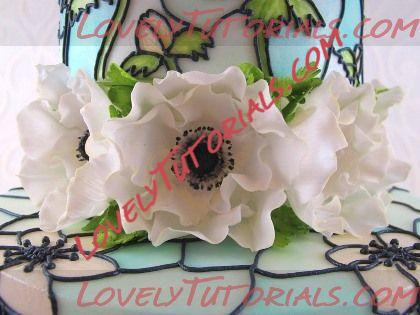
To start with, letвАЩs talk a little bit about this flower. The number of petals ranges from about 5-15, and they are generally an unsymmetrical flower with respect to the petal arrangement. The 6 petal flowers can be symmetrical and the petals are in layers of three, with the layer above over the joins of the layer below. As for the shape of the petals, usually they are rounded with a slight point at the tip, but can be rounded like a rose leaf or a poppy leaf. The petals of the open flower are generally not frilly, but those on the half open or older flower can be. These flowers are often represented as stylised on wedding cakes but here I am going for something a little closer to nature. These flowers come in a multitude of colours both pastel and vibrant, but white is the favourite for a wedding cake. The centre of the flower is black, with the colour underneath being pale green for the pistil/domed centre and the stamens are tipped black with the stem colour being a paler version of the flower colour.
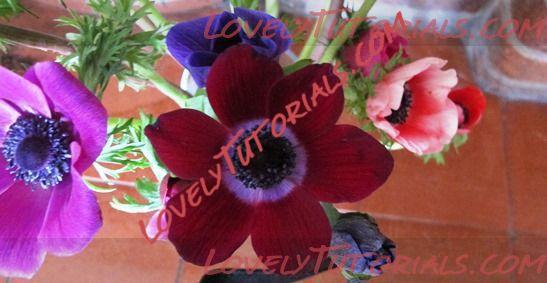
Make the flower centre:
1.Take some pale green flowerpaste/gumpaste and roll it into a pea sized ball, size 5 if you use the вА?Size GuideвАЩ (a very useful thing to have for flower making)
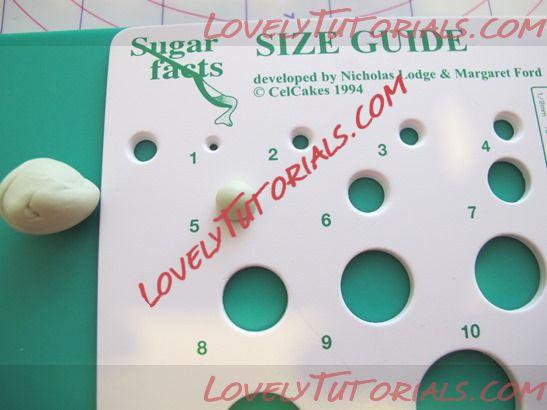
2. Next, flatten the ball at the bottom to form a dome or jelly tot shape
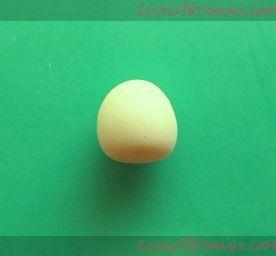
3.To give the pistil/central dome some texture, take a small pair of scissors (nail scissors are ideal, for sugar craft use only) and use the very tip of the scissors to snip out вА?vвАЩshapes, start at the bottom and work around, then upwards to the top.
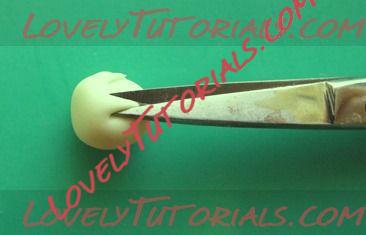 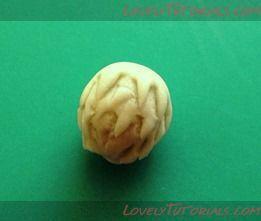
4.To give the pistil the appearance of being covered in pollen, insert a cocktail stick into the base, brush all over with edible glue and dip/roll it into black Sugartex or semolina which has been coloured black using edible food dust. If you have a little plastic pot (I recycle my edible glue pots) you can keep some ready coloured edible pollen ready to go.
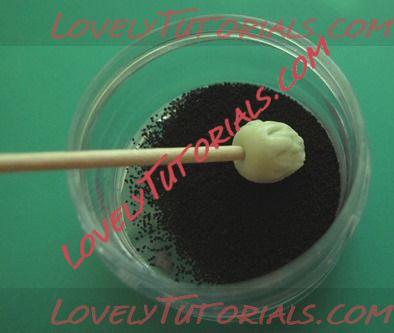
5. Gently remove the stick from the base and leave to dry in kitchen towel or alternatively push the other end of the cocktail stick into a foam/polystyrene block and remove the pistil once dry. DonвАЩt worry if there is little bits of green showing, this will just make it look more realistic. To stop the edible pollen from falling off the centre onto your cake you can set it by spraying with a little edible glaze spray.
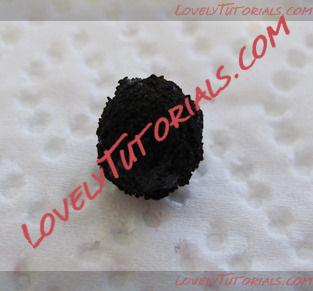
6.To make the stamens, thinly roll out some white flowerpaste/gumpaste. By thin I mean thin enough so you can read text through it (e.g. 0.5mm thick or less). To stop the paste sticking, rub a small amount of white vegetable fat/shortening on the board. You can also use cornflour but it will dry the paste out quicker.
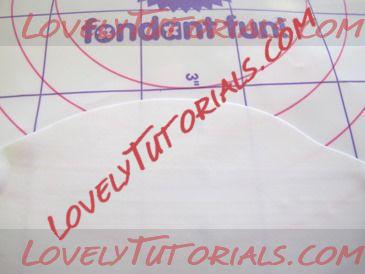
7. Cut out 2 of each of the smallest daisy plunger cutters from PME (or similar, they need to be two sizes that are big enough for the pistil to fit in). Store any cut-outs you are not working on under a stay-fresh mat or equivalent to keep them from drying out fast (steps 8 and 9 do not work well on paste that is to dry).
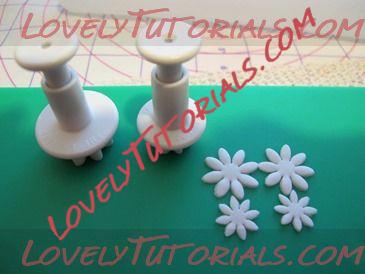
|

26.05.2013, 12:40
|
|
–Р–і–Љ–Є–љ–Є—Б—В—А–∞—В–Њ—А
|
|
–†–µ–≥–Є—Б—В—А–∞—Ж–Є—П: 05.03.2013
–°–Њ–Њ–±—Й–µ–љ–Є–є: 698
|
|

8.Take one of the two larger cut-out daisyвАЩs and using a scalpel/X-Atco knife, cut each petal into 4. I have a small Corian board for cutting so the plastic rolling board doesnвАЩt get ruined.
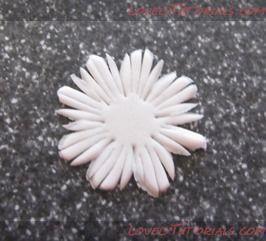
9. Take a small pair of tweezers with a fine pointed end (like the ones you can buy for plucking eyebrow hairs) and pinch in about 1mm down each stem to form a bulbous head
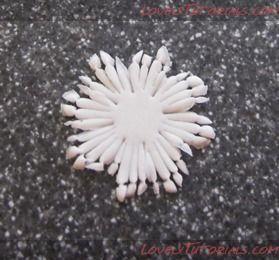
10. Prepare the other of the larger daisy cut-out in the same way and glue it on top of the first (with a small amount of edible glue), ideally so the stalks of the top layer cover the gaps in the bottom layer (interleaved). Place on a firm food grade mat (e.g. PME Mexican Foam Pad or equivalent), and cup/push into the centre using a medium sized bone/ball tool.
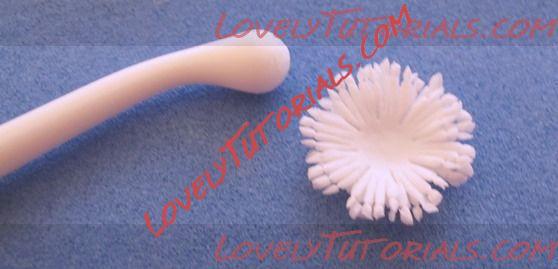
11. Repeat steps 8 and 9 with the smaller cut-out daisyвАЩs and stick the two layers together as described in step 10.
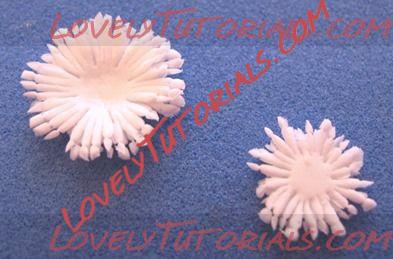
12. Apply a little edible glue to the centre of the larger pair and stick the smaller on top (again, interleaved if possible). Cup the centre again.
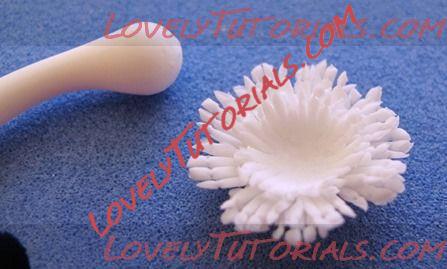
13. Apply a little edible glue to the centre again and stick the flower pistil in. Use the tweezers or scalpel to adjust the stamens and make the shape look more natural
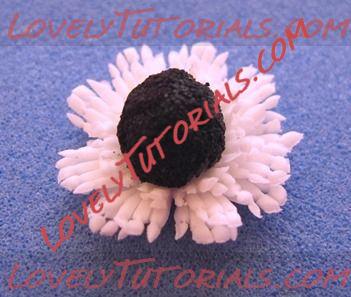
14. Place in a food use only paint palette or empty sanitised toffife candy (or similar) tray to keep the curved shape whilst drying
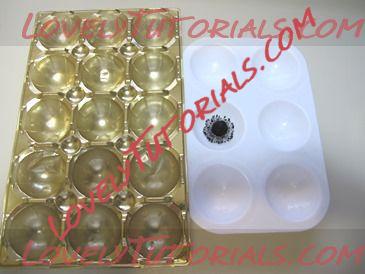
15. once dry, paint the stamen tips black using black food dust or paste dissolved in alcohol, re-juvinator spirit (iso-propyl alcohol food grade) or confectioners glaze (my preferred choice). Colour the stalks a diluted version of the petal colour. As these petals are white, I gave the stalks a grey tint to add depth.
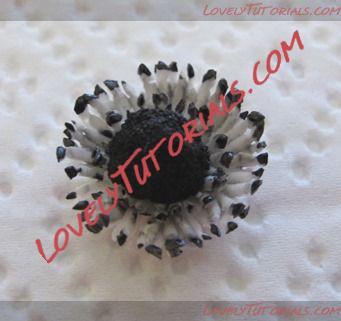
16. To make the centre more quickly, make the whole thing using black flower paste/gumpaste (no painting or spraying required) and do not cover the flower pistil in inedible pollen. The picture below shows what the two look like. Do whatever best suits, they both look effective.
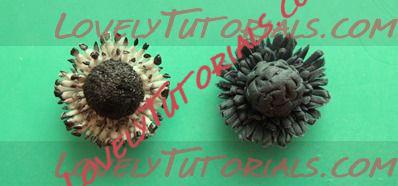 Make and stick together the petals
Make and stick together the petals
1. Roll out some white flowerpaste/gumpaste thinly (as shown earlier) and cut out one small circle, 4 small petals and 6 larger petals. Either use the template shown or the following/equivalent cutters; PME Briar rose cutter (BR 210) 2nd smallest circle, Tinkertech Two leaf 225-228 cutter (TT225-228), two largest cutters. You can also use a rose petal cutter and trim the rounded end of the petal into a point using small nail scissors (for food use). Store the petals you are not working on under a stay fresh mat.
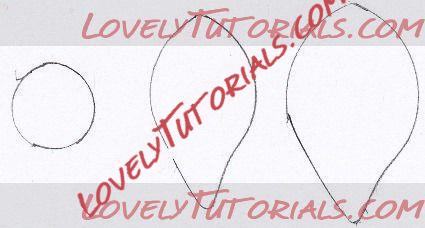 template вАУ actual sizes circle diameter approx.. 2cm, petal lengths approx.. 4.5 and 5cm template вАУ actual sizes circle diameter approx.. 2cm, petal lengths approx.. 4.5 and 5cm
|
 |
|
|
–Ь–µ—В–Ї–Є
|
anemone, anemono, anemoon, anlegget, anl√§ggning, an√©mone, armado de los ramos, arranjo, artesanatos passo a passo, augalas, baking, biljka, bitki, bloem, bloemen, blomma, blommor, blomst, blomster, blume, blumen, bl√Љten, bl√Љtenpaste, boeket, bouquet, buchet, buket, bukett, bukiet, buqu√™, cake decorating, cake decorating techniques, cer√Ґmica pl√°stica, chiodi di garofano, clavo de olor, clous de girofle, cloves, cold porcelain, cold porcelain figurines, cold porcelain flowers, confeitando bolos, csokor, cukrini≈≥ gƒЧli≈≥, curso completo de flores, curso de modelado, cvijet, cvijeƒЗe, decoracion de pasteles, decoraci√≥n de tortas, decorare le torte, decorazioni, deko fondant, dekorace na dort, dekoracija, dekoracije, dekorasyon, dekor√°cie, el abc del armado de ramos, fimo, fimo flowers, fiore, fiori, fleurs, floare, flogistica, flor, floral inspirations, flores, flores azucar, flores e folhas, flori, floristics, floristik, floristikk, floristique, flor√≠stica, flower, flower paste, flowering plants, flowers, flowers on a wire, folhas pintadas, fondan, fondant, fondente, fotopostup, gum pasta, gum paste, gum paste flowers, gumpaste, gumpaste flowers class, gƒЧlƒЧ, gƒЧlƒЧs, hand painting, handmade, handmodelliert, hideg porcel√°n, hladno porculan, how to, how t—Ж–≤–µ—В—Л –љ–∞ –њ—А–Њ–≤–Њ–ї–Њ–Ї–µ, impianto, kaldt porselen, kallt porslin, kalt porzellan, kasvi, kolde porcel√¶n, koud porselein, kukka, kukkakimppu, kukkia, kvetina, kvety, kvƒЫtina, kvƒЫtiny, kwiat, kwiaty, kylm√§ posliini, kytica, leaves, les an√©mones, making sugar flowers, mazzo, modellierpaste, modell…Щ≈Яdirm…Щ, modelovanie, modelov√°n√≠, modelowanie, montando, motivtorten, nelken, n√ґv√©ny, oasis o esponja de floristeria, pap, paso a paso, passo a passo, passo-a-passo, pasta flexible, pflanze, plant, planta, plante, plantes, plantƒГ, plukƒЧ, pocelana fria, polymer clay, polymer clay flowers tutorial, porcelaine froide, porcelana fria, porcelana fr√≠a, porcellana fredda, postup klinƒНek, postupak za ukrasavanje, puok≈°tƒЧ, ramo, rastlina, rece por≈£elan, rododendron, rostlina, ro≈Ыlina, sasanka, schritt f√Љr schritt anleitung, schritt-f√Љr-schritt, sculpey flowers, sculpting, simple, soƒЯuk porselen, stamens, steg for steg, step by step, step-by-step, strau√Я, studen√љ porcel√°n, styrofoam, sugar cane flowers, sugar cloves, sugar flower, sugar flowers, sugar flowers for cake decorating, sugar paste flowers, sugarcraft, sugarpaste, sukker art, tecnicas de decoracion, tecniche, thai flowers, torte, torte decorate, torten dekorieren, torti, trin for trin, trin-for-trin, trinn for trinn, tutorial, tutorijal, ukra≈°avanje torti, uo≈Њkabarzdis, uputstvo za dekoraciju, vir√°g, vir√°gok, vrtna anemona, vuokot, wedding cake, wedding cakes, windr√ґschen, wire, zawilec, zimno porcelany, zuckerblumen, аЄФаЄ≠аЄБаєДаЄ°аєЙ, а§Єа§Ьа§Њ а§Ха•За§Х, а§Ѓа•Йа§°а§≤а§ња§Ва§Ч, гГҐгГЗгГЂ, гВ§гГБгГ™гГ≥гВљгВ¶е±Ю, √Іi√Іek, √Іi√Іek modelleme, ≈°alto porceliano, еїЇж®°, и£Эй£ЊиЫЛз≥Х, йУґиО≤иК±е±Ю, …Щsm…Щ, мІДлЛђлЮ?, ќЇѕБѕНќ± ѕАќњѕБѕГќµќїќђќљќЈ, ќЉѕАќњѕЕќЇќ≠ѕДќњ, ќ±ќљќµќЉѕОќљќЈ, ќ±ќґќ±ќїќ≠ќ±, ќїќњѕЕќїќњѕНќіќє, ќїќњѕЕќїќњѕНќіќєќ±, ѕЖѕЕѕДѕМ, –Ї–≤–µ—В–Ї–∞, –Ї–≤–µ—В–Ї—Ц, –Ї–≤—Ц—В–Є, –Ї–≤—Ц—В–Ї–∞, –Ї—Г—Б—В, –≥–≤–Њ–Ј–і–Є–Ї–∞, –≤–µ—В—А–µ–љ–Є—Ж–∞, –њ–Њ–ї–Є–Љ–µ—А–љ–∞—П –≥–ї–Є–љ–∞, –њ–Њ–ї–µ–≤—Л–µ —Ж–≤–µ—В—Л, –њ–Њ—И–∞–≥–Њ–≤–Њ, –њ—А–Є—А–Њ–і–∞, –Љ–Ї, –Љ–Њ–і–µ–ї–Є—А–∞–љ–µ, –Љ–∞–є—Б—В–µ—А-–Ї–ї–∞—Б–Є, –Љ–∞—А—И–Љ–µ–ї–ї–Њ—Г, –Љ–∞—Б—В–Є–Ї–∞, –Љ–∞—Б—В–µ—А-–Ї–ї–∞—Б—Б, –∞–љ–µ–Љ–Њ–љ–∞, –∞–љ–µ–Љ–Њ–љ—Л, –∞–Ј–∞–ї–Є—П, –∞–Ј–∞–ї—Ц—П, –±—Г–Ї–µ—В, –Ј–∞–≤–Њ–і, –ї–Є—Б—В—М—П, –ї–µ–њ–Є–Љ —Ж–≤–µ—В—Л, –ї–µ–њ–Ї–∞, –ї—Ц–њ–ї–µ–љ–љ—П, —А–Њ—Б–ї–Є–љ–∞, —А–∞—Б—В–µ–љ–Є–µ, —А–∞—Б—В–µ–љ–Є—П, —Г–Ї—А–∞—И–µ–љ–Є–µ —В–Њ—А—В–Њ–≤, —Г–Ї—А–∞—И–µ–љ–Є–µ —В–Њ—А—В–∞, —Б–≤–∞–і–µ–±–љ—Л–є —В–Њ—А—В, —Б–∞—Е–∞—А–љ–∞—П –Љ–∞—Б—В–Є–Ї–∞, —Б–∞—Е–∞—А–љ—Л–є –Ї–ї–µ–є, —Г—А–Њ–Ї–Є –њ—А–Є–Ї—А–∞—И–∞–љ–љ—П, —Б—В—Г–і–µ–љ –њ–Њ—А—Ж–µ–ї–∞–љ, —В–Њ—А—В, —Д–Є–Љ–Њ, —Д–ї–Њ—А–Є—Б—В–Є–Ї–∞, —Д–ї–Њ—А–∞, —Е–Њ–ї–Њ–і–љ–Њ–≥–Њ –њ–Њ—А—Ж–µ–ї—П–љ–Є, —Е–Њ–ї–Њ–і–љ–Њ–≥–Њ —Д–∞—А—Д–Њ—А–∞, —Е–Њ–ї–Њ–і–љ—Л–є —Д–∞—А—Д–Њ—А, —Е–∞–ї–Њ–і–љ–∞–≥–∞ —Д–∞—А—Д–Њ—А—Г, —Ж–≤–µ—В–Њ–Ї, —Ж–≤–µ—В–Њ—З–љ–∞—П –њ–∞—Б—В–∞, —Ж–≤–µ—В–µ, —Ж–≤–µ—В—П, —Ж–≤–µ—В—Л, —Ж–≤–µ—В—Л –Є–Ј –њ–Њ–ї–Є–Љ–µ—А–љ–Њ–є –≥–ї–Є–љ—Л, —Ж–≤–µ—В—Л –Є–Ј —Е–Њ–ї–Њ–і–љ–Њ–≥–Њ —Д–∞—А—Д–Њ—А–∞, —Ж–≤–µ—В—Л –љ–∞ —В–Њ—А—В, —И–∞–≥ –Ј–∞ —И–∞–≥–Њ–Љ  |
|

